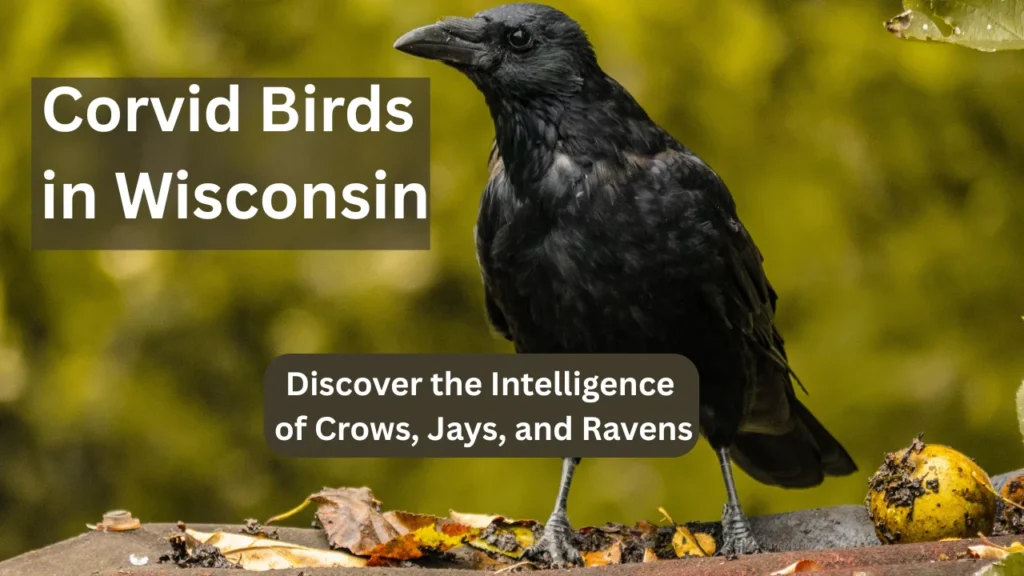Corvid birds include crows, ravens, jays, magpies, and nutcrackers. These birds live across Wisconsin and often draw attention for their loud calls, bold behavior, and dark feathers. Many people see them as pests, but corvids play an important role in nature. They are also some of the smartest birds in the world. This article explores the lives of Wisconsin’s corvids, how they think, where they live, and why they deserve more respect and understanding.
Corvid Birds in Wisconsin
| Species Name | Key Traits | Common Areas in Wisconsin |
|---|---|---|
| American Crow | Social, tool use, large flocks | Statewide, especially urban areas |
| Common Raven | Intelligent, playful, loyal mates | Northern forests, rocky habitats |
| Blue Jay | Vocal mimicry, seed caching, bold colors | Woodlands, suburbs |
| Black-billed Magpie | Collects objects, strong memory | Grasslands, scattered areas |
| Clark’s Nutcracker | Seeds hoarder, rare species | Northern pine forests |

What Are Corvids?
Corvids are part of the crow family. These birds are known for their black or bold-colored feathers, sharp beaks, and large brains. In Wisconsin, corvids live in both cities and rural areas. They adapt well to human environments and often appear in backyards, woodlands, or roadside trees.
What makes corvids stand out is how they think. They solve problems, use tools, and remember people. Some scientists compare their intelligence to that of young children. Many corvids even recognize faces and build relationships with humans.
Nightingale Supper Club: Door County’s Longstanding Dinner Tradition
American Crow: Loud, Smart, and Watchful
The American crow is one of the most common birds in Wisconsin. Crows gather in large flocks and often roam near farms, towns, and cities. They communicate using different calls and body movements. Crows even hold “funerals” for other crows by gathering and watching quietly.
Crows also use tools. They can bend wires to pull food out of containers or drop nuts on roads for cars to crack. Crows remember people who feed or threaten them and often avoid those they see as dangerous.
Common Raven: Mysterious and Loyal
Ravens look like large crows but have thicker beaks, wedge-shaped tails, and deeper voices. They are more common in northern parts of the state, especially in forested and rocky areas.
Ravens show loyalty to their mates and often stay together for life. They play games, slide on snow, and use simple tools. Ravens even hide food in secret spots and return weeks later to eat it. Their calls are varied and include knocks, rattles, and low croaks.
Burtons on the Bay: Lakeside Dining with Local Flavor in Door County
Blue Jay: Flashy Feathers and Sharp Minds
Blue jays are easy to spot. Their bright blue feathers and loud calls make them common visitors to feeders and backyards. But their beauty hides a smart and sneaky mind.
Blue jays often imitate the calls of hawks to scare off other birds. They collect and hide seeds in many locations, especially acorns. Some jays hide hundreds of seeds each fall and remember where to find them. This helps forests grow, as some forgotten seeds turn into new trees.
Black-billed Magpie: The Curious Collector
Magpies are not as common in Wisconsin but may appear in open grasslands and near farms. They have black and white feathers with long tails and strong voices.
Magpies collect shiny objects like coins, foil, or jewelry. This behavior, while playful, also shows strong memory skills. These birds build large stick nests and form strong family groups. They also clean up carrion and food waste, helping the environment.
Casperson Funeral Home: A Century of Service in Sister Bay
Clark’s Nutcracker: Rare and Resourceful
This rare corvid appears mostly in pine forests in the northern regions. Clark’s nutcracker stores pine seeds in the ground to eat during winter. It uses its beak like a tool and remembers thousands of hiding spots.
Its work supports tree growth. Many pine forests rely on this bird to spread seeds. Even in cold weather, the nutcracker keeps working, showing strength and skill in hard conditions.
Intelligence and Problem Solving
All corvids show signs of high intelligence:
- They recognize themselves in mirrors
- They create and use simple tools
- They solve puzzles to reach food
- They remember people, places, and events
- They use calls to share warnings and food locations
Some crows teach their young how to use tools. Others plan ahead by storing food in safe places. Their intelligence is not only instinct—it is learned, practiced, and shared.
Door County Rummage Sales: Your Ultimate Guide to Bargain Hunting
Why Are Corvids Misunderstood?
Corvids often scare or annoy people. Their black feathers, loud calls, and bold actions can give the wrong impression. Some people think they bring bad luck or damage crops.
But these birds help the environment. They clean up dead animals, spread tree seeds, and eat harmful insects. They also teach scientists about bird intelligence and how animals communicate and solve problems.
Corvids may not sing sweet songs, but their role in nature is just as important as any other bird.
Watching Corvids in Wisconsin
To observe corvids:
- Visit forests, farms, or city parks
- Look for flocks gathering near garbage bins, fields, or roadkill
- Listen for loud calls or clicks
- Set up feeders with nuts or suet
- Watch their behavior closely—they often move in groups and work together
Be patient. These birds notice changes quickly and may watch humans as much as humans watch them.
Alpine Resort Egg Harbor: A Century of Wisconsin Hospitality and Scenic Charm
FAQs
Wisconsin corvids include crows, ravens, blue jays, magpies, and nutcrackers.
No. While they may take food or eggs, they also clean waste, spread seeds, and balance ecosystems.
Crows and ravens use tools, solve problems, and remember people. Their intelligence is among the highest in birds.
Many do. Some, like crows and blue jays, remain through winter. Others migrate or move based on food sources.
Their bold behavior, black feathers, and loud voices create fear, but they are helpful and highly intelligent animals.
Corvid birds in Wisconsin bring intelligence, teamwork, and energy to the skies. They are more than just black feathers and loud calls. They think, plan, and adapt. They form bonds and support nature in quiet ways.
From the clever crow in a city to the nutcracker deep in a pine forest, corvids show how powerful and thoughtful birds can be. They deserve attention, respect, and protection not fear or misunderstanding.
